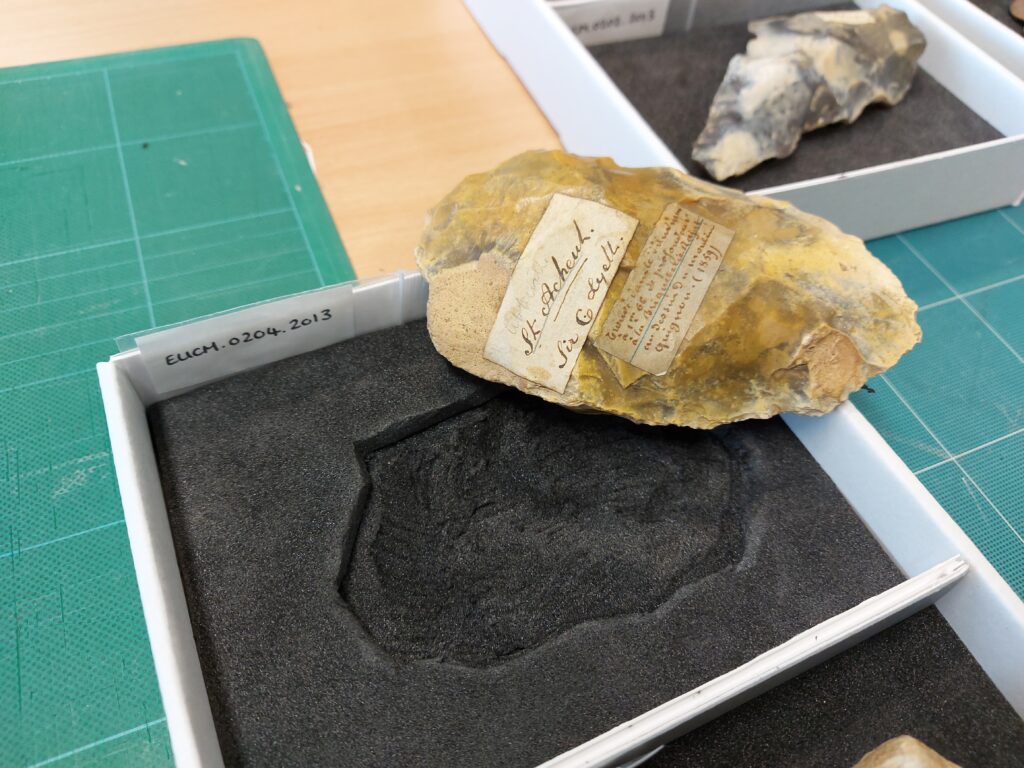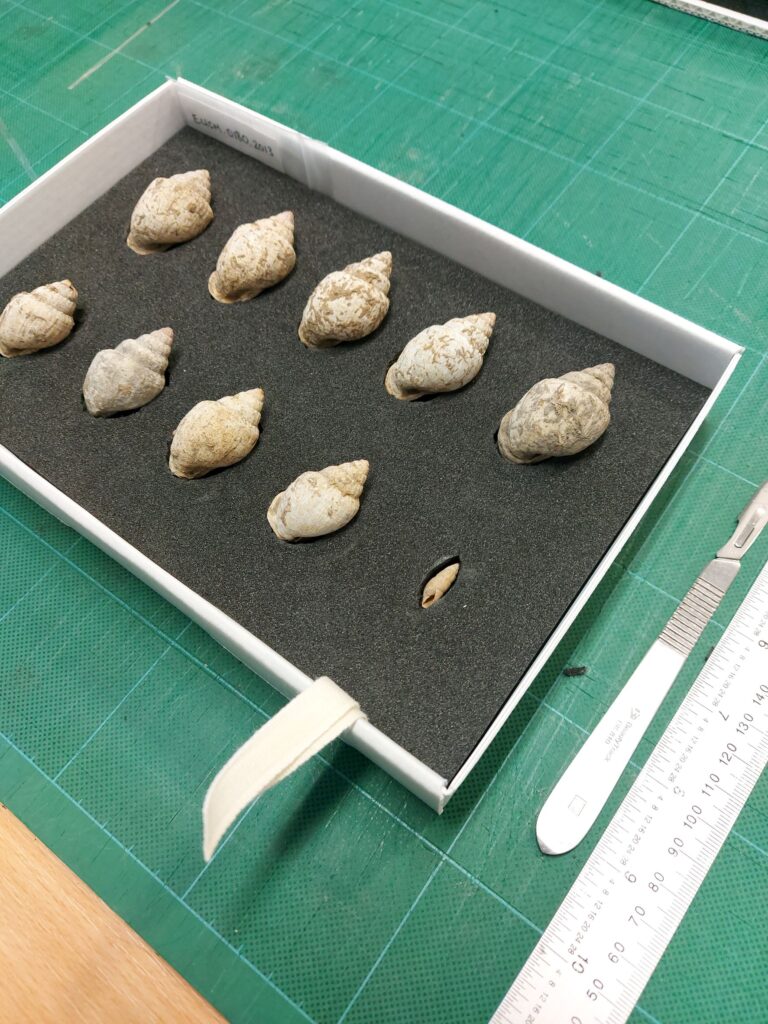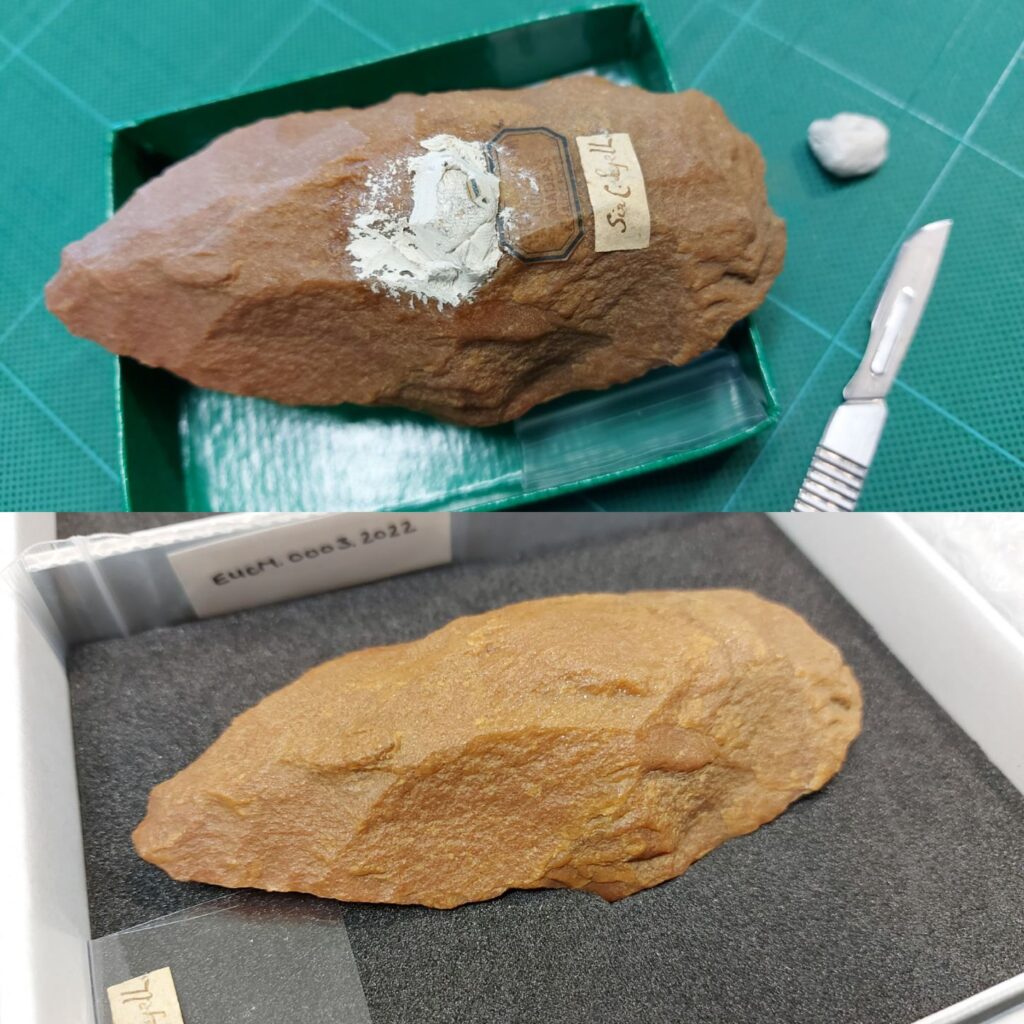In this post, our Technician, Robyn Rogers, discusses the recyclable book cradles she has developed as part of the conservation team’s ongoing work to make exhibitions at the University of Edinburgh more sustainable.
Category Archives: Charles Lyell
The Art of Asking: Requesting Loans for Exhibition
By Morven Rodger, Collections Registrar, Heritage Collections
As the Collections Registrar, one of my core responsibilities is coordinating loans from the University’s Heritage Collections to external exhibitions. Whenever an item from our collections is requested by another institution, I work with our conservators, curators, and technicians, while liaising with the borrowing institution, to manage the risks and help make the process as smooth as possible.
I am always excited by new loan requests, and the prospect of sharing our collections with broader audiences, but no loan is without risk, and lenders must balance the risks and benefits to justify their decision to lend. The loan request is a borrower’s opportunity to make their case, explain why they want to borrow, show that they understand the practicalities, and demonstrate the value our items will add to their exhibition.
Homes for Rocks – Rehousing the Lyell Geological Specimen Collection
Today we have the first installment of a two-part series from Joanne Fulton. Joanne is here on an 8-week internship funded by the John R. Murray Charitable Trust to help with the conservation of the collection of Sir Charles Lyell (1797 – 1875).
It is a privilege to handle objects that have been worked on by people in the past, to experience the connection and witness their working and learning processes. Therefore, it has been a fascinating opportunity to work on the rehousing of the Lyell Geological Specimen Collection which consists of various specimens from flint implements and axe heads, to shells and raindrop traces.
As previously outlined in these blogs, Sir Charles Lyell (1797-1875) was a hugely significant scientific figure in the 19th century. Amongst others, Lyell corresponded and was a close friend of another well known figure, Charles Darwin, a name closely linked to a number of the shell specimens within the collection I’m rehousing.
These specimens were collected or given to Charles Lyell on his many geological excursions. They were then used to inform his geological research, and they continue to inform learning and research within the University of Edinburgh today. When observing the many documents in the Lyell collection, I’ve found drawings of the same specimens I’m rehousing, illustrated by Lyell in his papers and notebooks.
In the first week I calculated I should be aiming to complete at least 5 objects per day to finish within the 8 weeks of my internship, as I had to bear in mind that within the 168 objects to be rehoused there are groups of items – here I’m largely referring to the shells – that make up a single object. However, as I reach the end of week 4, I’ve found I’m now completing over 10 a day due to more efficient preparation.
The materials I have been using to rehouse the specimens includes card tray compartments and plastazote, a type of foam used in archival repackaging. I have several sizes of trays, however there are 6 specimens which are too large for the largest of trays and need their own custom boxes. I’ve made these myself with card and corrugated card.
My process for rehousing a specimen begins having prepared the tray and two layers of plastazote to fit within. I then cut into the plastazote as appropriate to the rock. Using a white pencil I mark out where I need to cut through the top layer of plastazote, and then using a sharp scalpel, I carve into the thicker bottom layer. This carving is continued until the specimen sits tight and will continue to do so in the future when the specimens are returned to their storage.

A sharp scalpel is needed to create a neatly cut support for each specimen (EUCM.0204.2013)
All this cutting creates a lot of off-cuts from the plastazote. Rather than wasting them, I shall be reusing them as padding for a Tyvek book cushion in order to make my project more sustainable.
Previous to my rehousing, some of the rocks were held in small green trays of a standard size, often not suited to the actual size of the specimens and offering no added protection. The shells, which I shall be rehousing next week, are in small red boxes.
Included with many of the specimens are extra notes and labels of various origins – some of Lyell’s own handwriting – which also need to be housed with the object as part of their history. When this is the case, I create a third layer of plastazote to house this paper note slipped in a melinex sleeve, carving a little recess for it to sit flat. I then attach cotton tape to the middle layer so the user can lift the object to see the paper note when needed.

Shells after rehousing: A note stating these shells were collected by Darwin is stored underneath (EUCM.0180.2013)
The majority of these specimens are in good condition – they are rocks and so robust by their composition- the labels, many handwritten by Lyell, and other attachments to the object are less so. Many are in need of repair having suffered losses, crumpling, and have become detached from the specimen. This is a problem I shall be tackling in the second half of my internship; repairing the tears and losses, as well as reattaching the labels with an adhesive.
There have also been a few messy surprises and oddities in the collection, with one rock having a large amount of white tack attached, unfortunately this was also stuck to the rock’s labels. This white tack was removed, and the same tack was used to remove the tiny amounts left in the small crevices on the rock surface. I carefully removed the labels from the rock and the tack, removing the unwanted and potentially damaging tack mechanically from the paper labels.

Photo during and after removing white tack from one of the specimens (EUCM.0003.2013)
Having recently graduated from the paper conservation course at Northumbria University, its been a rich learning curve working with objects such as the geological specimens. In my second blog, I plan to examine the method of reattaching the loose labels to the specimens as well as the finalisation of the rehousing within the second half of my internship.
Righting Letters – Conserving the Lyell Collection
Today we have the first installment of a two-part series from Sarah MacLean. Sarah is here on an 8-week internship funded by the NMCT to help with the conservation of the collection of Sir Charles Lyell (1797 – 1875).
As my career in conservation progresses, I find myself drawn most to objects and collections that give insight into the more personal, human aspects of history and heritage. Kings and Queens and famous faces are all very well but I’m more interested in the lives of everyday people – in their passions and machinations, and in how they interacted with the world around them.
Throughout my studies and previous work, I have had ample opportunity to see and conserve this kind of history. Most recently, I worked on the conservation and digitisation of the 1921 Census of England and Wales where I saw first-hand the lives of ordinary people, a snapshot of the nation captured in a single day. And now, as an intern working on the Sir Charles Lyell Collection, I see similar opportunities to preserve and elevate the more unique and personal aspects of the great man’s life.
Sir Charles Lyell (1797 – 1875) was a Scottish geologist and scholar whose discoveries informed a significant shift in our understanding of the Earth and its history. Lyell posited that the geological processes that shaped the Earth are still active in the modern era and through extensive fieldwork, travel, popular lectures, and his best-selling books, he became internationally famous and respected by many scientific communities.
He also corresponded with near-innumerable members of these communities with professional and personal relationships often spanning the entirety of his career in the same way that his precious notebooks do. It is this varied and extensive correspondence that I have been working steadily to conserve and rehouse during my time at the Centre for Research Collections.

A letter from Lyell’s correspondence before and after conservation treatment
This part of the Lyell Collection comprises 22 boxes containing thousands of letters and other documents. Typically, I assess and conserve 1-2 boxes in an average working day and so anticipate completing this work by my 6th week here at the CRC. I re-label each folder of correspondence individually before assessing and conserving its contents as needed. Typically, this work extends to flattening folds and plane distortions, surface cleaning using chemical sponge, undertaking tear repairs, and infilling small lacunae using Remoistenable Tissue (lightweight Japanese paper impregnated with an adhesive that is reactivated with moisture).
My work on the 1921 Census prepared me well for my work on the Lyell correspondence – not only have I built considerable aptitude with my chosen repair material, but I also greatly enjoy the nitty-gritty remedial nature and consistency of the work. However, this consistency and regularity is not to say that the Lyell correspondence has not already yielded some wonderful surprises.
Often, these surprises have come in the form of unique drawings, maps, and other larger format works coloured with an array of aesthetically pleasing pigments. From the coastline of Louisiana to coal deposits in the Scottish Highlands, these works have the potential to tell us not only about Lyell’s working processes and the areas of study he thought most important, but to give greater insight into his personal quirks alongside those of the people with whom he corresponded.

A small drawing showing an erupting volcano illustrating Lyell’s interest in volcanology.
These larger works often pose interesting conservation challenges too. Their scale means that they have been folded to fit their envelopes or other housings and the mechanical stresses this puts on the paper has led in many places to weakness and tears. The repairs that I undertake must not only be neat and visually pleasing but must also be robust enough to withstand handling and consultation as well as the object itself being carefully folded again and returned to its housing.
I have also had the opportunity already during my time at the CRC to tackle Lyell’s collection of geological specimens and discovered a heretofore unknown little example of such a specimen within his correspondence – another pleasant surprise.
Crumpled within a small envelope, I have been unable yet to discover what type of stone these pieces are comprised, but I have been able to rehouse them, encapsulating them in Melinex for the time being so that they can be viewed and consulted without the need for direct handling.

Two small geological samples discovered within an envelope in Lyell’s correspondence.
All the work I have undertaken thus far on the Lyell correspondence has been done with that knowledge that the collection is, at its core, is to be used and learned from. This need for accessibility interests me just as much as the unique and personal stories within Lyell’s correspondence because I believe strongly that the more accessible we are able to make the Lyell Collection and others like it, the greater the impetus will be for such treasures to be preserved and protected in the future.
